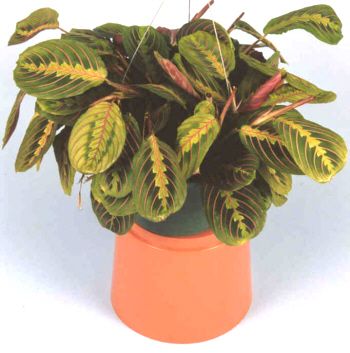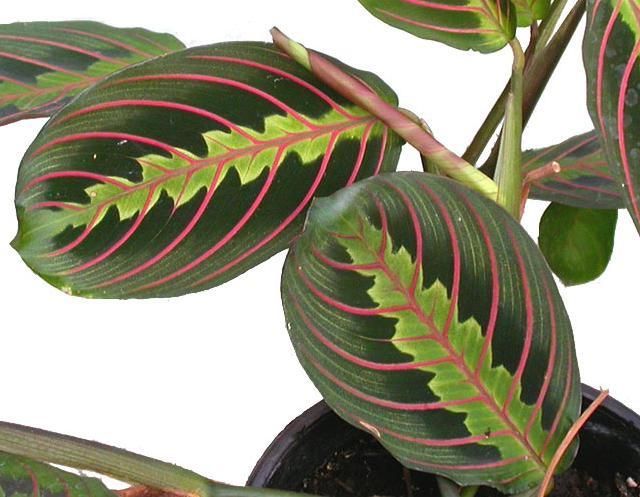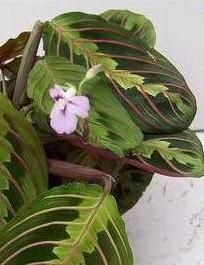Maranta leuconeura

Common name: Prayer Plant, Banded arrowroot, Rabbits tracks
Family: Marantaceae
Origin: Brazil
Hight: 12-18 in. (30-45 cm)
Width: 10-20 in. (25-50 cm)
Sun Exposure: Light Shade, Partial to Full Shade
Blooming Time: Spring and Summer
Desription:
Small tropical plant with broad oval leaves, up to 8 inches long by half as wide, with low bushy habit. To conserve moisture, the leaves fold upwards at night , hence the common name. The small white flowers have purple spots. Flowers are not particularly showy. It is grown for it's variegated, smooth-textured foliage: blue-green, burgundy, bronze-green. The spotting on the leaves turns to a dark green as it ages.
Cultivation and care:
Prayer plants Maranta leucoreura need full shade, warm temperatures and very high humidity to thrive. They do best in a warm greenhouse or a terrarium. Provide medium or bright filtered light, but never direct sun. Use a well drained soil with a little peat moss added, because they need a slightly acid soil; use a soil mix consisting of 2 parts peat moss to 1 part loam to 1 part sand or perlite. Keep the soil evenly moist but never soggy and never allow it to dry out. When plants rest in winter keep the soil drier and allow it to dry between waterings. Do not allow water to stand on the crowns; the stems rot easily. Fertilize weekly with a balanced fertilizer diluted to 1/2 the strength recommended on the label. Ideal temperatures are between 60 and 85 degrees.
Since the plant has a shallow root system it should be planted in shallow pots. The plant responds to being trimmed at least twice a year. Trimming helps to keep the plant growing vigorously. Re potting should only be done if the plant out-grows its container. Repot in early spring if needed, at which time you can propagate new plants by division.
Propagation: Maranta leuconeura are easily propagated by division.
Pests and diseases:
- Dry air will be a problem in the winter, and this is probably the cause of the brown leaf tips. Putting the plant in among several other house plants will help to create a more humid atmosphere. Another aid would be to place a bowl of water in the immediate vicinity of the plant. Another possible cause of the problem could be chlorine or flouride in the water supply. This can be alleviated by using bottled water, or allowing the water to sit in an open container for 24 hours before using it.
- Maranta may "die" back for a period after blooming. Keep up regular care of plant and it will start to grow again.
Articole asemănătoare
-
Insemnatatea ecologica a culturilor de Paulownia
In Orientul Indepartat, plantele din genul Paulownia sunt renumite pentru rapiditatea cu care se dezvolta, si sunt clasificate in 17 specii. Numele lor generic a fost acordat in cinstea fiicei tarului Pavel I al Rusiei, Regina Anna Pavlova a Tarilor de Jos.
-
Probleme cauzate de caldura exagerata si uscaciunea aerului
Primele semne ale disconfortului florilor noastre sunt incetinirea cresterii si chiar stagnarea in dezvoltare. Plantele se opresc din crestere, nu mai produc frunze sau boboci
-
Calathea zebrina (Maranta zebrina)
Frunza este ovala, cu lungimea de 30-35 cm, cu suprafata catifelata de culoare verde deschis, cu dungi late mai inchise la culoare pe directia nervurilor si cu reversul purpuriu.
-
Maranta(M. leuconeura - Maranta bicolor)
Este una dintre cele mai frumoase plante decorative prin frunze, dar si una dintre cele mai putin rezistente la conditiile de camera. Este confundata cu Calathea, deosebindu+se prin aceasta prin talia mai mica si cresterea usor taratoare a lastarilor. Are frunzele petiolate, larg ovale, cu un dinte scurt in varf. Fata superioara a frunzei are culoarea verde deschis, cu pete maronii, iar reversul purpuriu.
-
Plante de interior usor de intretinut
Cele sase plante pe care vi le vom prezenta in continuare cresc aproape singure, fara sa necesite tratamente speciale. Cea mai mare problema pe care o veti intampina cand vine vorba de ingrijirea lor este sa va hotarati ce sa faceti cu puietii pe care ii produc...

